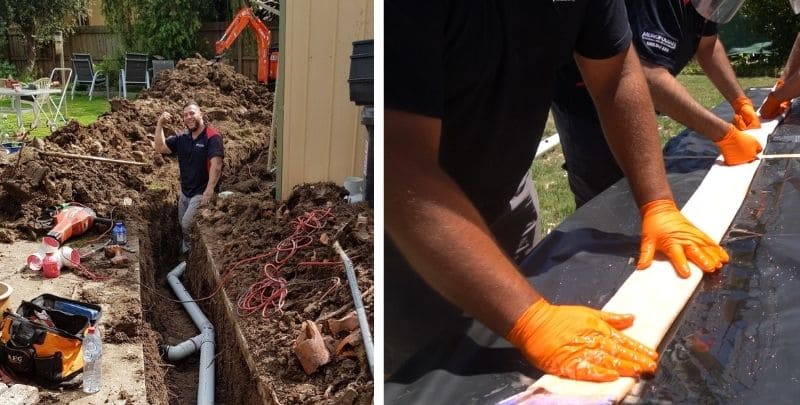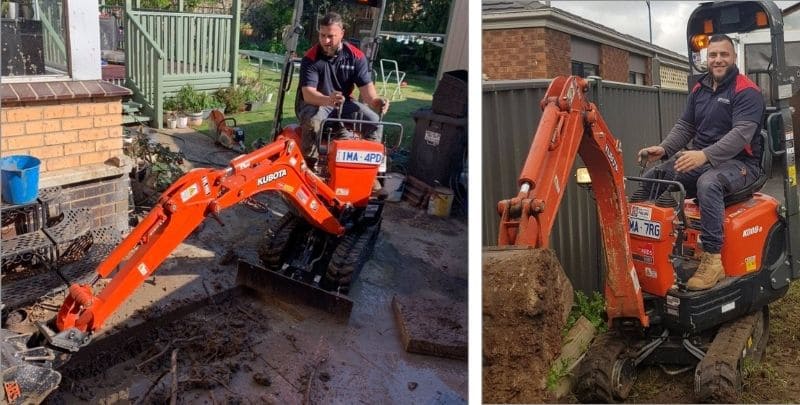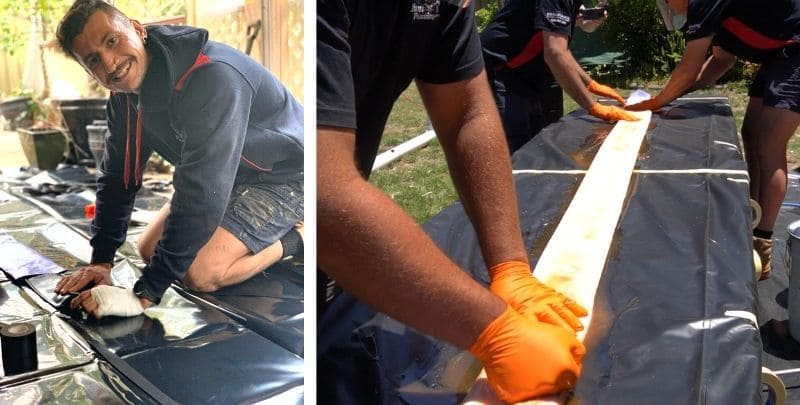
The Lowdown On Pipe Relining Vs Replacement
The inconvenience of blocked drains or sewer pipes on your property is something no homeowner ever wants to go through. If tree roots or a burst pipe have created a severe blockage in your sewerage system, a plumber may recommend relining the pipes or replacing them via drainage excavation to address the issue. Unsure of which method will work best for you? There are numerous factors to consider, so Metropolitan Plumbing is here to break down sewer pipe relining vs replacement for you.
Pipe replacement involves a team of plumbers digging trenches, removing concrete slabs, dismantling walls and anything else above ground to locate and completely replace a piece of pipe. Pipe relining effectively repairs the broken pipe from the inside out, using only a small access point of one square metre.
What is Drainage Excavation?

For a long time, the only way to repair damaged pipes and sewer lines was with drainage excavation and pipe replacement. Plumbers will typically use this method for severely blocked pipes when traditional methods prove unsuccessful.
First, your plumber assesses the site to ensure they do not disrupt any gas or electricity lines. They need to precisely locate the blockage to ensure they only dig up the affected area for pipe replacement. To make sure the entire process is as efficient and stress-free as possible, the plumber will conduct a pre-excavation assessment.
Following the assessment, the plumber begins digging. Depending on how deep the pipes are buried, the plumber may need to install safety measures around the site. They can use excavator machines for the digging process, however, it is quite often safer and less disruptive to dig by hand.
After Excavation Comes Pipe Replacement
Once the plumber has excavated the damaged pipe from the site of the blockage, they can commence the pipe replacement process. In some cases, it may be possible to repair the pipe. However, this is often just a temporary solution and will lead to the problem (and the excavation process) reoccurring in the future.
With other pipe relining techniques becoming available, excavation thankfully isn’t always required and is largely considered to be an absolute last resort option. Drainage excavation requires a whole team of plumbers and can take a few days to complete. Moreover, the process involves digging up your garden and potentially ruining the landscaping. On top of paying for a costly excavation and pipe replacement, you’ll also be up for landscaping costs to get your garden back in shape. These reasons are why we often find pipe relining wins out in the pipe relining vs replacement debate.
Drainage Excavation Pros and Cons
While it sounds all doom and gloom, there are some pros to drainage excavation:
- Can be more cost-effective if the pipe is shallow in the ground or the excavation is simple.
- Sometimes the only available method.
That said, this option is still usually the last resort method due to its many down sides:
- Time intensive process.
- Loud.
- Messy.
- Inconvenient.
- Ruins your garden/landscaping.
- Requires a team of plumbers.
- Costly labour and tools.
So how does it compare to pipe relining?
What is Pipe Relining?

Despite being available for a few decades now, for many people sewer pipe relining is still a relatively unfamiliar pipe repair method. Drainage excavation requires a team of plumbers to dig up your yard to locate the damaged pipe and replace it. Pipe relining, however, is a no-dig method for pipe repair. It only requires a small entry hole for a pipe relining specialist to access your pipes.
The major win for relining in the drain pipe relining vs replacement debate is that pipe relining is a more cost-effective method to repair broken pipes from the inside out. The process involves inserting and inflating an epoxy resin-covered tube into the already damaged drain pipe. When the inflated tube is flush with the pipe walls, the resin adheres to it. This forms a hard protective coat inside the damaged area of the pipe and seals it. Your sewer pipes are just about brand new!
Before inserting the inflatable tube for pipe relining, the plumber must clean out the existing pipe. They will typically use an electric drain cleaner or a hydro jet for this step. The plumber will use CCTV drain cameras to inspect the pipes to ensure they are ready for pipe relining. With the tube inside and inflated, the resin must be left to cure. When the resin is cured, it has hardened and formed a seal on the inside of the pipe.
Pipe Relining Pros and Cons
Thanks to its many advantages, most plumbers and homeowners prefer pipe relining over traditional pipe replacement for addressing blocked drain and broken pipe issues. These advantages include:
- Less invasive process.
- Less time-intensive process.
- Provides a lasting, long-term solution when done correctly.
- A pipe relining project typically comes with a longer warranty.
There are some cons associated with pipe relining, however.
- It’s not suitable for all broken pipes (depending on the severity of the damage).
- The materials can be costly.
- Roots can grow into un-relined sections of pipes.
- The same problems can occur if the relining is not done correctly.
All in all, both effectively repair pipes, but which is the best pipe repair method?
Is Pipe Relining Worth It?
When comparing pipe relining vs. drain pipe replacement, pipe relining has a lot of benefits going for it and is an excellent method for pipe repair. From cracks to damage from tree roots, pipe relining can repair it all. It is more cost-effective than pipe replacement by drainage excavation and, in most cases, can be completed in a day.
Only a small access point must be dug, meaning the pipe relining process is far less disruptive to your garden and landscape. It’s also a handy preventative method. Homes with old pipes can have pipe relining done before major structural issues occur. To top it off, the life expectancy of relined pipes is between 20-50 years depending on the material! Damage from tree roots is a thing of the past when pipe relining is an option.
If pipe relining is so good, why do we still offer pipe replacements then? For all its benefits, pipe relining won’t work in all scenarios, making pipe replacement and drain excavation a necessity from time to time. Hence, the pipe relining vs. replacement debate begins.
If the old pipe has been damaged beyond repair, relining can’t save it. Severely damaged pipes must be excavated and replaced with a new pipe. Similarly, if invasive tree roots or a large obstruction results in a stubborn blocked drain that can’t accommodate the pipe relining tube inside, the process won’t work.
Pipe Replacement vs Pipe Relining Cost
Aside from the disruption and mess factors, pipe replacement costs can get a bit high; another reason why we always consider the process to be a last resort option. Where possible, we recommend pipe relining first as it is more cost-effective and will minimise disruptions to your home.
When it comes to drainage excavation, you need to factor in the labour, tools, materials, size of the excavation area and the depth of the new pipe. When it comes to pipe relining, you mostly just need to consider the pipe relining cost per metre.
Thankfully, here at Metropolitan, we offer interest free** payment plans to eligible customers, so you can get your plumbing flowing again without having to pay a cent upfront for both pipe relining and pipe replacements.
Facing a pipe problem you just can’t shake off? Contact Metropolitan and we’ll have one of our experienced plumbers at your door to assess the problem and start work today!
Need Help?
Give us a call or contact us below and we’ll have your blocked drains sorted in no time.
Published: 2020-07-27

















